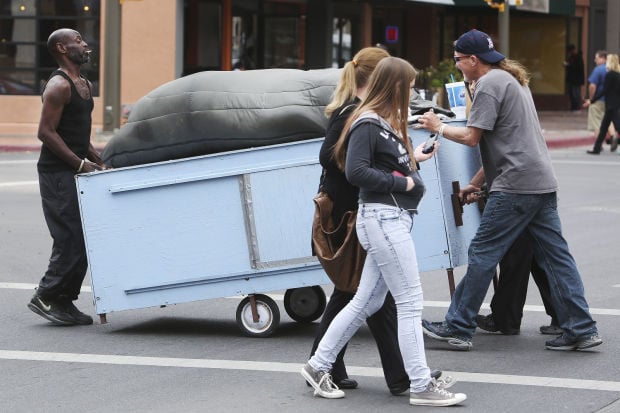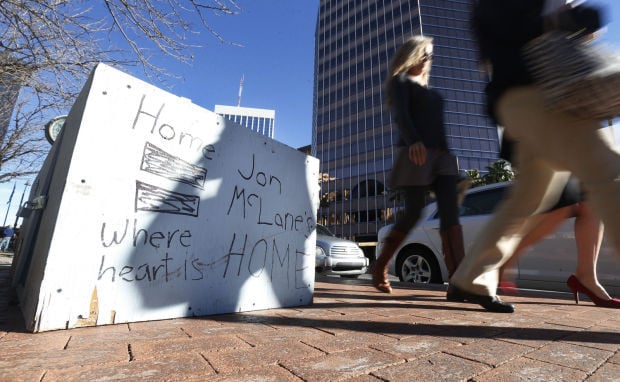The city has new rules about how much stuff homeless people can put on busy sidewalks.
It’s the city’s latest attempt to address problems that arose during the Safe Park homeless encampment and protest earlier this year. The city is trying to regulate sidewalk obstructions without criminalizing homelessness, said City Attorney Mike Rankin.
Here’s how a homeless person could follow the new rules, which take effect in 30 days.
- Sleep on a city sidewalk between 10 p.m. and 7 a.m. in downtown and university area commercial zones.
- Have a maximum of 4 cubic feet of stuff on the sidewalk, including backpacks, blankets and other belongings.
- Keep stuff 5 feet back from the curb, leaving a clear walking space for passersby.
- After 7 a.m., stay in a city park with your personal belongings during the day, until 10 p.m. when the park closes. Sitting or lying down on a busy downtown sidewalk is not allowed during the day.
If a person is in violation of the rules, a police officer could ask the person to move or issue a citation.
The new rules were approved by the Tucson City Council in a 5-2 vote Tuesday. Council members Karin Uhlich and Steve Kozachik voted no.
The vote came just before 10 p.m. Protesters held signs that said “Tell me where to sleep” and “Needs must be met, not criminalized.”
A block away from City Hall, at Veinte de Agosto Park, about a dozen people were sleeping on the sidewalk on Church Street.
The park in downtown Tucson was the site of the Safe Park protest, which grew out of the Occupy Tucson movement last year.
The protesters won an injunction in U.S. District Court that prevented the city from enforcing a policy that allowed people to have a backpack, a bedroll and a beverage with them on the sidewalk without being considered an obstruction.
The judge said the rule was unfair because those are the specific items a homeless person would have.
The city has an ongoing appeal in the 9th U.S. Circuit Court of Appeals and is waiting for a ruling.
Now, instead of defining the types of items a person may have, the city is trying to define how much stuff and the size of stuff a person may have without obstructing the sidewalk, Rankin told the council.
Without size limits, the city could see the return of sleeping pods on sidewalks, Rankin said.
Person-sized plywood boxes for sleeping and storing stuff were used by Safe Park protesters in the spring and summer and were clustered on downtown sidewalks for several blocks around Veinte de Agosto Park. The city closed the park because of safety and health problems, effectively ending the protest and clearing out the camp.
The council previously considered a ban on urban camping as a way to address the protest-related problems but decided against it.
Uhlich criticized the new rules as making it a crime to be homeless. “I really think we’re crossing the line,” she said, “because who else other than a homeless person might have 4 cubic feet worth of stuff on the sidewalk with them after a certain hour?”
She also said the move is a waste of police resources. “I don’t want my TPD resources spent chasing around homeless people to see if they can get a measurement of their backpack,” Uhlich said.
She said she’s worried the city could end up back in court or even put its federal funding for housing programs at risk.






